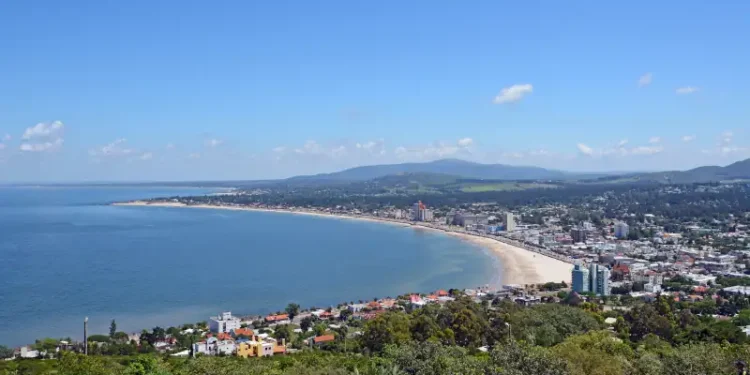Founded in 1890 by an alchemist named Francisco Piria, who was attracted by the area’s energy and magnetism, Piriápolis was Uruguay’s first resort town. And, by the 1930s, it was the country’s most popular thanks to its sandy beaches, calm waters, and attractive riverfront.
Piriápolis seems to be on the ocean, but it’s actually located on Río de la Plata… the river that separates Uruguay from Buenos Aires. The river is 129 miles wide at this point (210 km)—and your visual horizon is only about three miles—so it certainly feels like you’re on the Atlantic.
If you grew up in the eastern U.S. or ever spent summers on the New Jersey shore or similar, you’re likely to be hit with a rush of fond memories as you drive into town. The old buildings, seafood restaurants, and people sunbathing or strolling along the boardwalk perfectly echoes life in the 50s…
There are around 9,000 full-time residents in town but in the summer (you’re on the Southern Hemisphere, so the seasons are reversed here; the height of summer is January), Piriápolis is jammed to the seams as vacationers come to enjoy the friendly ambiance, seafood restaurants, casinos, and, of course, the beaches.
Piriápolis is also popular with boaters, home to two marinas on a coastline that has few places to moor a boat. The marinas—which are relatively new—have become popular in their short lifetime. The tourism department recognizes them as a now significant contributor to their bottom line.
One of the most appealing features of Piriápolis is that it’s walkable. At most downtown locations, you’ll get by easily without a car. For trips to Montevideo, Punta del Este, or their international airports, Piriápolis offers a frequent, modern bus service with free Wi-Fi.
When we speak of Piriápolis, it’s worth taking into account some of the town’s outlying areas: Playa Hermosa, Bella Vista, Las Flores, and Playa Verde are located along the riverfront road west of downtown Piriápolis and enjoy easy access to the conveniences of the city.
Heading east from town, Punta Colorada is a point that juts out into the waters of the Río de la Plata about five minutes from downtown and is particularly desirable because a well-situated house can have a 270-degree view of an awesome section of coastline.
Everyone in Uruguay is entitled to quality medical care via the national health care system—this includes foreign residents. If you prefer the extra services that the private system offers, there are many higher-end private hospital associations. The cost is reasonable, plus there are fewer people waiting and better conditions.
Piriápolis is not only unique in Uruguay, but its ambiance is unique in our experience anywhere outside the United States…
And make no mistake, one of its biggest draws is that it’s in Uruguay: a First World environment with low crime levels and a high standard of living… a country that offers a solid financial system, a strong agricultural base, and a friendly, welcoming culture.
If you’d enjoy a small, friendly town on the coast—that calls to mind 1950s America—than Piriápolis could well be for you.
Sincerely,
The Editors Of Live And Invest Overseas











